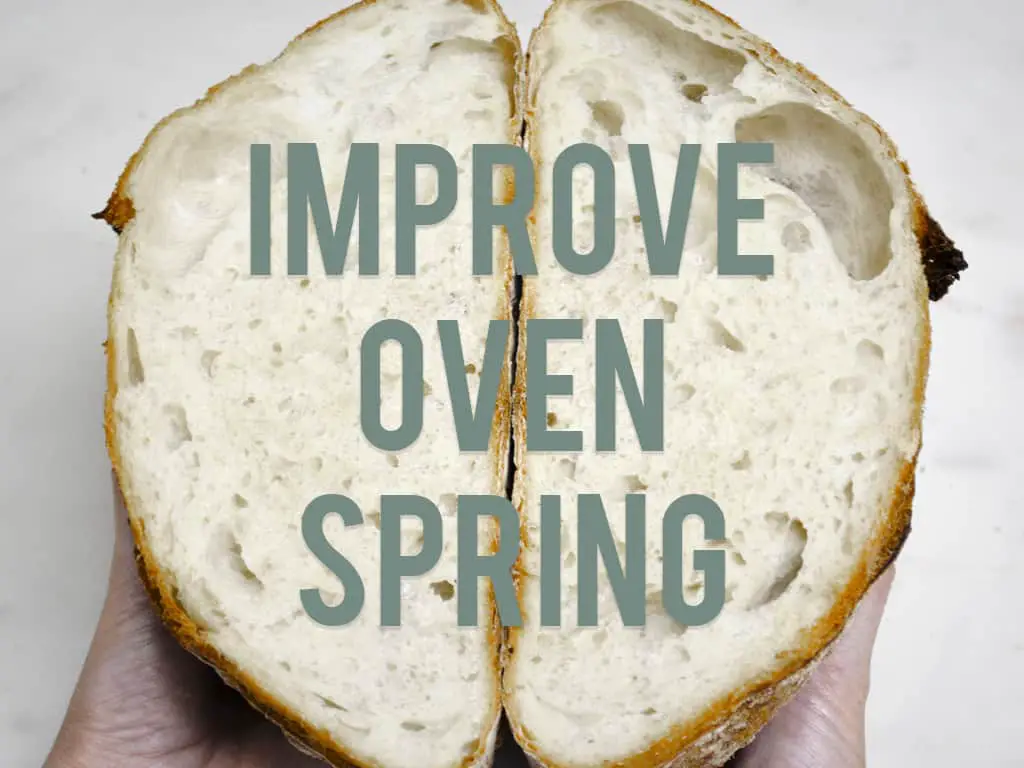For the longest time after we finally decided to start making sourdough, we were having highs and lows (I refuse to write a blog without a pun) when it came to oven spring. Don’t get us wrong, even sourdough is a simple process once you get the timing all figured out, but we had a serious case of oven spring jealousy going on. Our sourdough was just fine, and our friends and family loved it but we would have a decent spring with one batch and at times nearly zero spring for another. Drove us crazy!
So we went deep on this one. It was an embarrassingly nerdy process that lasted for several months, but we think we just might have cracked the code on this one. I hope these simple tips will work for you if you’re where we were a few months ago!
We’ll get to the tips in great detail in just a second, but in short, if you’re having problems with little or no oven spring you likely need to fix your starter strength, your dough structure, and your proofing temperatures. It might be one of those issues alone, or it could be all three.
We found when we pay attention to all three of these areas we have our best chance at great oven spring. However, the last area in this post (proofing temperatures) is by far the biggest factor for us. In fact, since we made that last tweak, we have not had a bad oven spring yet. So stick around until the end, or I guess, you can just skip ahead. That works too. 🙂
Starter Strength
Before we get into the nitty-gritty (channeling my best Nacho Libre impersonation as I typed that, which isn’t very good by the way), we’ll just make a quick note of differentiating between a starter and a levain. It took us a long time before we really knew the difference, and just want to ensure we are on the same page. Simply put, a levain is a fed portion of a starter that will go into your dough mixture. Conversely, your starter is the portion you’ll keep for future feedings. Many home bakers feed their starter, us included, and just bake with a portion from that once it is ripe. Others use a separate container to pour their starter in before feeding. Both are essentially the same thing. If you want more on this topic, check out our post on levains. But, anyhow, cool, let’s jump in.
A strong starter is important as it will maximize the energy throughout the entire process of making your sourdough. It is a LONG process, so we want as much energy as we can get. That being said, a levain or portion of your starter might pass the ripe test of floating in water, yet it will still be a bit sluggish over the long haul. Which makes it a bit of a challenge when trying to ensure your starter or levain is strong enough. So, we want to ensure the starter itself is happy and healthy long before doing the ripe test.
The most common reason for weak starters has to do with the feeding schedule of a starter. But, don’t think you have to feed it all the time to keep it strong. You essentially have a few options and standards to stick to in order to have your starter ready for the task of great oven spring:
- If you store your starter in the fridge and feed it about once a week, it will be strong and healthy that way. All you need to do is pull your jar out of the fridge, give it a feeding and it will be ready to go in anywhere from 4 to 8 hours later depending on how warm your environment is.
- If you store it in your fridge longer than a week without feedings (we tested on a starter that had gone months before a feeding), then simply feed it a couple of times before using. If you want to bake on Tuesday, for example, simply pull it out Monday morning, and feed it. Discard a bit Monday night and feed it once more before bed. Leave it out overnight and it should be happy and ready for Tuesday morning.
- If you store it out on the counter, feed it once a day to keep it happy and ready to go. If you forget a day here and there it will be just fine. But if you’ve gone several days, it will likely need a couple feedings to be happy again.
We have a blog post on how to know when your starter is ready to use. It covers both a new starter and what to look for when feeding a mature starter. Check it out here for more on this topic: How Do I Know When My Starter Is Ready To Use.
Ensuring your starter is fed for the job and fully active is the foundation for quality oven spring, as it will ensure your dough will start out with enough energy to complete the entire process.
Dough Structure
Sourdough is typically a high hydration dough, which is much more difficult to get used to working with. We found that in the early days we struggled to give it a good shape because it was just too sticky and floppy. But we have found some ways to easily build good structure, and avoid some of the hassle of working with high hydration dough.
- Don’t skimp on the stretch and folds. You want to squeeze in at least a few stretch and folds during the bulk fermentation phase. We like going with four, maybe five when we’re not too busy, over the course of our bulk process. We find it makes the dough easier to shape later as it is less floppy and messy to work with later.
- Don’t over-proof the bulk phase. When we first switched over from yeasted dough, we were expecting more bang out of the gates as we get with yeasted doughs. This meant we were letting the bulk go for way too long waiting to see big changes. Stick to the bulk time of your recipe, not waiting until you see billions of bubbles. You will see those bubbles often, especially when it’s warm in your kitchen, but at the same time, you often won’t. Our rise has been on point for a while as long as we hit our times for bulk and proofing. Going too long at room temperature will ensure you’re running out of energy and creating a mess to work with.
- Use a metal bench scraper if you can’t keep it from sticking like glue to your hands. Switching from working with just our hands to a plastic dough scraper helped, but then we moved on to a metal one and it made shaping so much easier. Better shaping builds better tension, which makes for better oven spring. I made ours as a gift for Carrie, but if you want us to do the leg work to find one for you, this one is a popular choice: Good Grips Bench Scraper. You can still make bread without it, but you’ll definitely want one if you’re looking to do this wet sourdough thing more often.
Essentially, you will want to do whatever it takes to get good structure and quality shape during the bulk and shape phases. For extra insurance, we do what is called a pre-shape about 10 to 20 minutes before we actually shape for added insurance. You can see how we do it for a basic round loaf in these two videos below.
Pre-Shape
Final Shape
Proofing Temperatures
Perfecting our process of proofing temperatures has been the game-changer for us. This has to do with a few key factors, but ultimately having a long cold second rise or proof is what made all the difference for us.
Without a doubt, once we switched our process to a room-temperature bulk and a long cold second rise we started having nice big springs, and have yet to have a bad one since. After fixing our bulk phase problem where we were going too long, we struggled to get good development, especially during summer. It gets really hot ’round our neck of the woods. So the solution for us was giving our dough a long cold proof in the fridge. This gave it plenty of time to develop.
Here are some things to consider here:
- If you’re doing both your bulk and proof at room temperature you quite likely are burning through your starter’s energy before gluten development and structure is in place.
- Doing a cold-proof ensures the dough has plenty of time to develop with the ADDED support of the proofing baskets/bowl AND the structure from final shaping. We let our dough sit in the fridge for 12 to 24 hours, which is a lot of time to develop under the support of the final shape and basket.
- Cold dough is stiffer, which means it is less likely to flatten out when you score, prepare, and transport the dough to your pan or stone. Gravity is brutal with wet dough. Especially when it is warm. This cold method resists the forces of gravity (take those physics!). But note, it will still pull your dough down eventually, it just happens slower when it is cold.
- This is just a guess, but we also think that the cold dough must somehow react and steam better as well.
So, to be absolutely clear, we think the long cold bulk has by far had the biggest impact for us. As we have become better and better at shaping and working with dough. It has had less of an impact than it initially did, but it is still the best way to improve your bread. The long cold-proof is amazing. Refrigerators are a modern marvel!
But! The three together have really improved our consistency, and ultimately the process is so much easier now that these three aspects are dialed in.
To recap, in the simplest terms:
- We keep our starter in the fridge, using it once or twice a week, which means we feed it once or twice a week to keep it healthy and strong.
- We do a room-temperature bulk ferment with 4 to 5 folds mixed in over the course of 3-4 hours.
- We shape with the aid of a bench scraper and do a cold final rise that lasts at least 12 hours, baking immediately after pulling from the fridge.
Maybe you were making some of the same mistakes we were, and this just might help you get that coveted oven spring you’re looking for!

